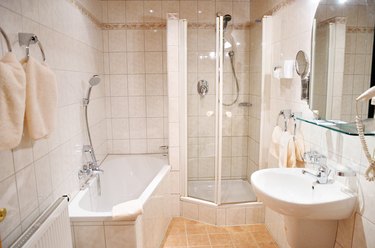
Mineral deposits or hard water stains affect all types of shower surrounds, including acrylic or plastic. Up close, these spots make the surfaces within a shower look slightly dirty even when they're clean, and they may not wipe off with regular soap and water. Vinegar cuts through even old, stubborn hard water spots with ease, but you may need to do a little scrubbing to completely remove the minerals from your shower.
DIY Hard-Water Stain Remover
Video of the Day
While you could use a commercial product formulated to remove mineral deposits, also called hard water spots, it's less expensive and quite easy to make your own water-spot remover from just vinegar and water. Inexpensive white vinegar is ideal for the job, and it's sold by the jug in many grocery and drug stores. Since you already know your home has hard water, it's a good idea to use distilled water for your hard-water spot remover, rather than water from the tap, so your solution doesn't lead to more mineral buildup.
Video of the Day
Mix equal amounts of white vinegar and distilled water in a spray bottle, then spray the shower down with the vinegar mixture. Open a window and be careful not to get the spray in your eyes if spraying above head height. Feel free to spray the shower handles and other fixtures, as well as the tub, if the bathroom has a shower and tub combo. This vinegar spray removes minerals from all sorts of surfaces, including metal, glass, fiberglass, and acrylic, so it's great for numerous cleaning projects in the bathroom and the kitchen.
Preventing Hard Water Stains
Unless you add a water softener to your home, the water coming from any tap could create mineral buildup or hard water stains on nearby surfaces. These chalky mineral deposits happen when hard water, which contains minerals such as calcium, evaporates. As the water evaporates, the minerals do not; they simply harden in place. It's the same type of buildup that leaves water spots on glassware after washing and air-drying the glass. Over time, particularly inside a shower, these mineral spots become more numerous and more obvious.
To prevent hard water stains or mineral deposits from building up inside your shower, wipe the shower down after each use. A small squeegee kept near the shower is the easiest way to do so; simply wipe down the shower surround with the squeegee once you're done showering. The less water left on the shower walls, the lower the likelihood of mineral buildup.
An old towel or a microfiber cloth comes in handy if you don't have a squeegee. Wipe the shower walls and all hard shower surfaces with the towel or cloth after each shower use. Drying these surfaces also reduces the chances of mildew or mold developing within the shower, as these substances thrive on excessive moisture. Add the homemade vinegar spray to your regular bathroom cleaning routine for an added preventive measure. Spray all surfaces inside the shower once a week, or whenever you regularly clean the shower, then wipe the liquid off with a soft cloth after 10 or 15 minutes.